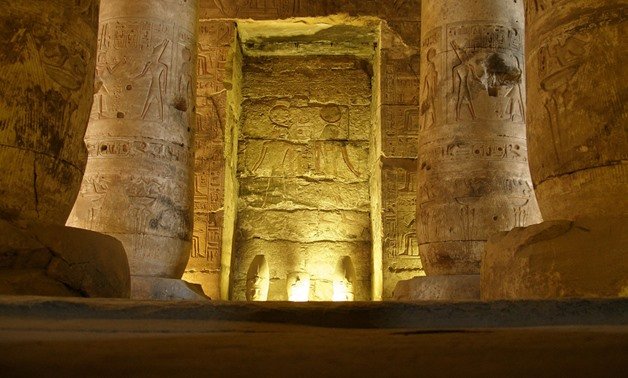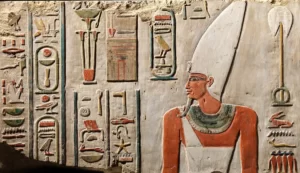Abydos Temple, an ancient Egyptian city located approximately 500 kilometers south of Cairo, holds a significant place in the country’s rich history. Dating back to the Predynastic period, Abydos witnessed the rise and fall of dynasties and the evolution of religious beliefs. This article will explore the historical significance of Abydos, with a particular focus on its early origins, political transformations, and the enduring worship of the god Osiris, as exemplified by the magnificent Osirian Temple.
Early Significance
In the early days of Egyptian civilization, Abydos, situated near the ancient city of Thinis, emerged as an important burial site for regional rulers. A significant landmark known as Umm el-Qaab, often referred to as the “Mother of Pots,” marked the beginning of Abydos’s historical significance and underscored its sacred nature from the very start.
Political Shifts and Spiritual Emergence
Around 3000 BCE, a pivotal shift occurred in ancient Egypt when Memphis became the new capital. As a result, Abydos experienced a decline in political importance. However, this transformation marked the beginning of its spiritual significance. With the Memphite necropolis becoming the preferred burial site for pharaohs, Abydos evolved into a sacred center, drawing pilgrims and devotees seeking spiritual enlightenment.
Abydos Temple as a Cult Center for Osiris
By the Old Kingdom period (around 2200 BCE), Abydos had established itself as a major center for the worship of Osiris, the god of the afterlife. This significant shift in the city’s identity marked a transition from political power to spiritual significance. The fusion of Osiris with the ancient canine god Khentiamentiu further solidified Abydos’s association with the afterlife and earned it the title “Lord of Abydos.”

Religious Practices and Processions
During the First Intermediate Period and the Middle Kingdom, the worship of Osiris at Abydos flourished. A significant annual procession took place, starting from Umm el-Qaab and leading to the presumed burial site of Osiris. This ritual demonstrated the profound belief in the spiritual connection between Abydos and the afterlife, solidifying its status as a sacred pilgrimage site.
Middle Kingdom’s Architectural Flourishing
The Middle Kingdom marked a significant period for Abydos, witnessing the flourishing of the cult of Osiris. Pharaoh Senwosret III, renowned for his devotion to Osiris-Khentiamentiu, constructed a magnificent mortuary complex at South Abydos. This architectural masterpiece represents the peak of Osiris worship during this era, showcasing the profound impact of the god on ancient Egyptian culture.

Abydos Beyond Middle Kingdom
Although Abydos continued to be a significant religious site after the Middle Kingdom, particularly during the 19th Dynasty with the construction of Seti I’s temple, it was during this period that the worship of Osiris reached its zenith. Abydos’s enduring legacy as a sacred site and its profound influence on ancient Egyptian culture and spirituality remain evident to this day.
Frequently Asked Questions
Why was Abydos essential in the past?
Abydos served as a burial ground for local rulers, making it a significant spot during the Predynastic period. Think of it as the first-class lounge for ancient dignitaries.
How did Abydos change politically?
Memphis stole the political spotlight around 3000 BCE, leading to Abydos focusing more on spirituality. It’s like Abydos traded its politician hat for a priestly robe.
Who is Osiris, and why is he a big deal in Abydos Temple?
Osiris is the ancient Egyptian version of the afterlife VIP. By 2200 BCE, Abydos Temple became his go-to spot, making it a spiritual epicenter. It’s like Osiris chose Abydos as his favorite hangout joint.
Any cool events in Abydos Temple?
Yep, during the First Intermediate Period and the Middle Kingdom, they had annual processions from Umm el-Gaab to Osiris’s assumed burial place. Think of it as a yearly spiritual parade.
What’s up with the Middle Kingdom architecture?
The Middle Kingdom was like Abydos’s golden era. Senwosret III built a fancy tomb, showcasing his love for Osiris. It’s like he threw a lavish party, and everyone was invited to admire his devotion.
Conclusion
Abydos encapsulates a remarkable narrative of transformation, from a political hub to a spiritual sanctuary. The Osirian Abydos Temple, as a focal point within this historical context, symbolizes Abydos’s transition and its enduring significance as a center for Osiris worship. The journey from political eminence to spiritual eminence defines Abydos’s unique place in the annals of ancient Egyptian history.
